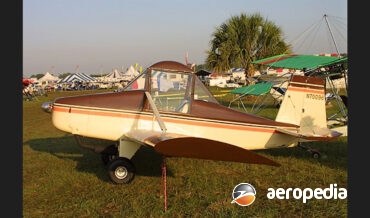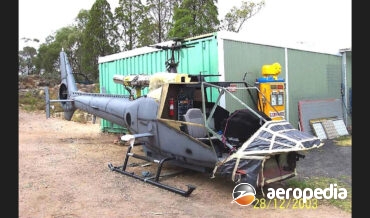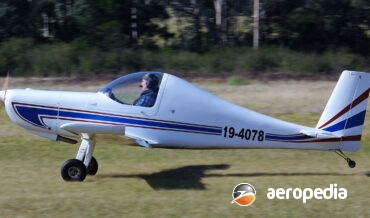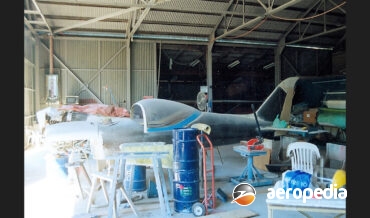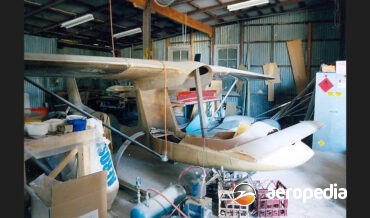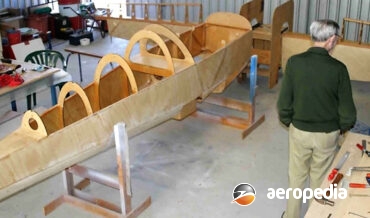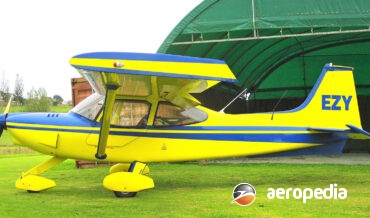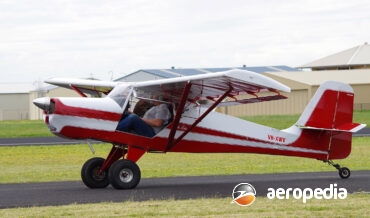David C. Eyre
In the 1920s Robert Burton commenced construction of a light monoplane aircraft at Tempe, NSW in a shed, stating he was using parts from an Avro 504 he had obtained.
David C. Eyre
- May 25, 2020
The X6 was designed in New Zealand as a tandem, two-seat shoulder-wing high-performance sporting monoplane in the late 1970s and construction of a prototype commenced.
David C. Eyre
- May 25, 2020
The Wolff WRD-01 project was begun by Bryce Wolff in 1994, being a self designed and built aircraft originally aimed at registration as an ultra-light in the 95.10 category.
David C. Eyre
- May 25, 2020
Very little is known about this aircraft but it seems it was placed on the RAA register on 8 November 2006 as 19-4806 (c/n H-20001) and remained on the register for two years, being withdrawn from use on 31 October 2008 and was removed from the register.
David C. Eyre
- May 25, 2020
The Supercat was a single-seat low wing monoplane marketed by Bowdler Aviation Inc of Beavercreek, Ohio.
David C. Eyre
- May 25, 2020
The Bonnie was built by Mr Ronald Gower using an incomplete project commenced by L J R Jones. Powered by a converted Henderson motor-cycle engine, its first flight was scheduled to occur at Pyes Estate at Quakers Hill, west of Sydney, on 18 December 1932, but engine problems delayed the
David C. Eyre
- May 25, 2020
Blue Thunder was a 1980s film made in the United States using a highly modified Aerospatiale Gazelle helicopter.
David C. Eyre
- May 25, 2020
This aircraft commenced life as a Micro Aviation B-22 Bantam but was modified to some extent by the owner/builder John Black of Ngaruawahia, NZ.
David C. Eyre
- May 25, 2020
The Swift was designed and built by Mr Walter Szajnoha of Hazelbrook, NSW and was completed and flown in 2004, being registered under RAA regulations as 19-3159.
David C. Eyre
- May 25, 2020
The Nova is a single-seat low-wing all-composite high-performance light aircraft designed and built by Walter Szajnoha of Hazelbrook, NSW, being registered under ultra-light regulations as 19-4078.
David C. Eyre
- May 25, 2020
The Bennett Condor ZK-CON (c/n 001) was built basically along the lines of a CAB Minicab but using Jodel D-11 plans, this enabling the builder to meet New Zealand micro-light class weight restrictions.
David C. Eyre
- May 25, 2020
Mr George Bellchambers, who lived in an Adelaide suburb, built a glider of his own design in about 1919 and an attempt was made to fly the aircraft at Wall Flat on the Murray River but this was not successful.
David C. Eyre
- May 25, 2020
This was one of a series of aircraft designed and built for the September 1909 Defence Department competition for the best and most suitable aeroplane for military purposes.
David C. Eyre
- May 25, 2020
This was an ultralight aircraft which, on 27 March 2002, was registered 19-3706 (c/n 231) with the RAA and was fitted with a Lycoming 0-320 engine. It was struck off the register on 12 July 2011.
David C. Eyre
- May 25, 2020
One of a number of light aircraft designed by Gary Morgan. It was a development of the Cheetah but was heavily modified, having a new tail and elevator and an enlarged fin.
David C. Eyre
- May 25, 2020
This glider was an American design of the late 1920s and one example was built from plans by AMSCo in Victoria in about 1928.
David C. Eyre
- May 25, 2020
On 21 May 1914 Mr J E Bailey flew an aircraft of his own design and construction at Bacchus Marsh, Vic for the first time.
David C. Eyre
- May 25, 2020
This was a three -axis two-seat ultralight monoplane designed and built by Paul Badcock. It was of all metal construction with a fibreglass engine cowling and a tricycle undercarriage.
David C. Eyre
- May 25, 2020
This ultralight aircraft was designed and built by Australian Aero Engines Corp. Little is known about it but it became 19-3974 (c/n 1) and was registered from 16 September 2003 to October 2006.
David C. Eyre
- May 25, 2020
This was an aircraft built in Adelaide in about March 1915. It was fitted with a 19-kw (25-hp) Anzani engine installed in a pusher configuration.
David C. Eyre
- May 25, 2020
This was an ultra-light aircraft designed, built and flown by Christopher Conroy, who later designed the Sparrow and Sparrowhawk range of light aircraft.
David C. Eyre
- May 25, 2020
Very little is known about this aircraft. It was placed on the RAA register on 27 January 2005 as 19-4255 (c/n CAA-001) and removed on 27 January 2006.
David C. Eyre
- May 25, 2020
Designed and built by Mr Raymond Tolhurst of Composite Aero Components of Camden, NSW, the White Pointer was one of a series of high-performance light sporting aircraft designed by this company aimed at the sport aviation fraternity.
David C. Eyre
- May 25, 2020
This aircraft was designed by Mr Raymond Tolhurst as an all-composite light sporting aircraft for his Company Composite Aero Components of Camden NSW.
David C. Eyre
- May 25, 2020
The Colby is a single-seat ultralight aircraft built by Mr Colin Thorpe and is basically a Flightstar modified by the builders to meet their needs.
David C. Eyre
- May 25, 2020
The Imp is a light aircraft of all wood construction with fabric covering designed and built by Murray Cohoe at Serpentine in Western Australia. It was nearing completion late in 2007.
David C. Eyre
- May 25, 2020
As noted elsewhere, Steven Cohen came from a background of hang gliding and was a successful manufacturer of hang gliders.
David C. Eyre
- May 25, 2020
Steven Cohen, along with Colin Winton, is recognised as one of the most prolific designers of Ultralight Aircraft in Australia.
David C. Eyre
- May 25, 2020
This aircraft was designed by prolific aircraft designer in Australia, Steven Cohen, in 1983. It is an extremely simple aircraft and, other than for the tail it was all straight tube and plate.
David C. Eyre
- May 25, 2020
This is an amphibian designed and built by prolific designer and builder, Steven Cohen, at Wedderburn, NSW, with work commencing in 2018 and continuing into 2019.
David C. Eyre
- May 25, 2020
The Cobra was a one-off single-seat light sporting aircraft fitted with a four-cylinder engine with a fixed tailwheel undercarriage and registered with the RAA on 4 April 2002.
David C. Eyre
- May 25, 2020
The Cli-Mate commenced life as a Foxcon Terrier 200 but received some major changes during its construction. It initially became ZK-EZY² (c/n NZ2006) and was registered on 21 July 2004 to the Paul Hopper and Rex Swenson Partnership.
David C. Eyre
- May 25, 2020
This was an ultralight aircraft designed and built by Mr Alan Clarke. It was powered by a Fuji Robin 250 engine and had an empty weight of 84 kg (186 lb).
David C. Eyre
- May 25, 2020
The Kingfisher is a one off two-seat low-wing cabin monoplane designed and built by Mr Clark. This aircraft is powered by a 90-kw (120-hp) Jabiru 3300 six-cylinder engine and was first registered as 19-7104 on 24 March 2009.
David C. Eyre
- May 25, 2020
The Cielo Lobo is a light sporting aircraft built by amateur builders. Work commenced on the construction of the first Australian aircraft in 2002 and it was eventually completed and registered with the RAA on 21 July 2010 as 19-7577.
David C. Eyre
- May 25, 2020
In Queensland early in about 2000 an amateur constructor designed and built a scale replica of a twin-engine, push/pull, Cessna 337.
David C. Eyre
- May 25, 2020
This aircraft was a glider imported from the United States where it had operated as N642BA (c/n 101A-0187) It was first registered in Australia as VH-BII on 5 March 2008.
David C. Eyre
- May 25, 2020
This aircraft was a homebuilt Vans RV-4 quick-build kit constructed by Carl Wright of Ventura, California and was registered in the United States as N67CW.
David C. Eyre
- May 25, 2020
In about 1935 Keith Cameron built a small single-seat monoplane. It was of wood construction with fabric covering. It was not thought to be intended to fly and was only used for taxiing training duties.
David C. Eyre
- May 25, 2020
Nothing is known about this aircraft at this stage but it was registered as VH-XFB (c/n Freckle 1) to its owner Adam Barrow of Murrumbeena, Vic on 16 March 2017.
David C. Eyre
- May 25, 2020
Recent Comments
Archives
Categories
- No categories
Categories
- No categories
Latest Posts
Newsletter


